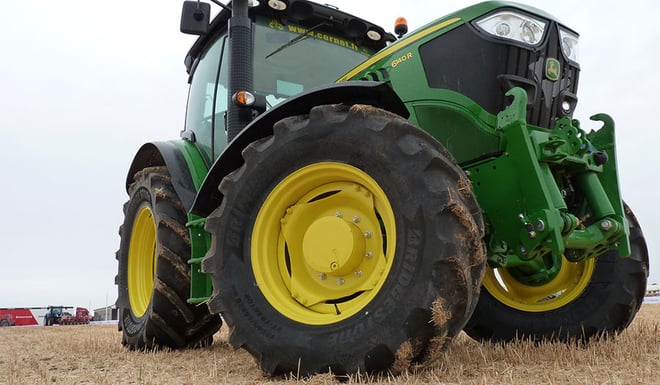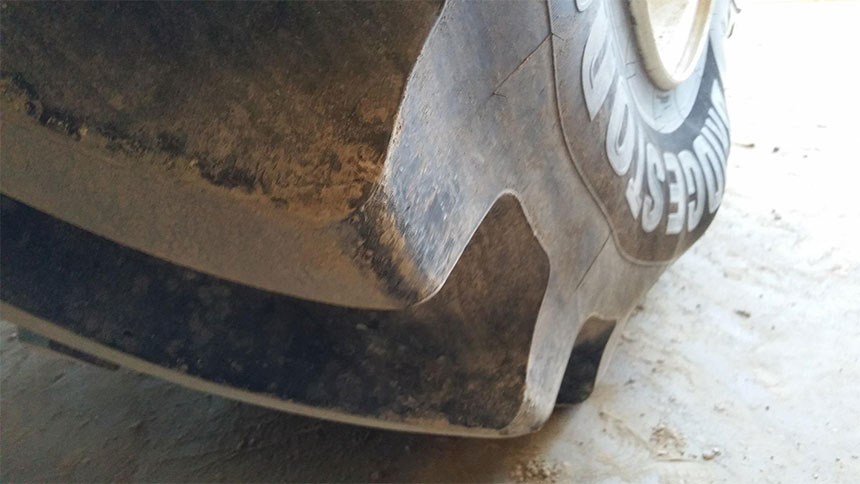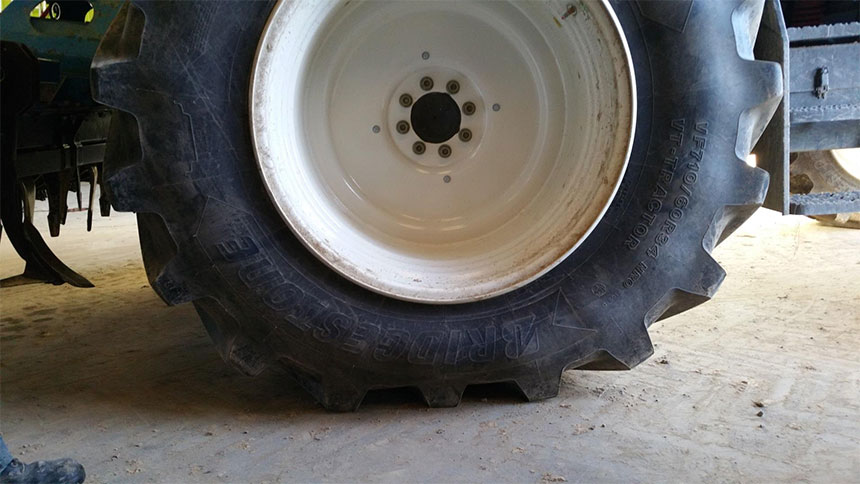There are many technical notions concerning your agricultural tyres that are worth knowing and understanding, because they can help you improve the quality of your work and your yields.
One such notion is the loaded radius, which designates the distance from the centre of the tyre and the ground. The shorter the distance, the better the traction, the more you preserve your soil and the less fuel you consume. It’s very simple to measure and in a few seconds you will be able to tell whether your operations will be efficient and profitable.
The information in this article will help you understand exactly what the loaded radius is:
1. What is the loaded radius and what does it tell you?
When you place weight on a normal tyre, you can see the flattening out effect at the bottom of the tyre at ground level. The pressure is spread evenly within the tyre but the deflection only takes place at the level of the ground. The reason for this is that the contact patch with the ground is the balancing area between the weight of the machine and the ground’s bearing capacity.
The tyre has an unloaded radius which corresponds to its dimension, but when loaded, it flattens out onto the ground.
The dimension is therefore no longer the same between the centre of the hub and the ground if you take this crushing effect into account.
This is known as the static loaded radius. The latter has an influence on the lead ratio and gives an indication of the tyre’s ability to work at low pressure and thus reduce rolling resistance, improve traction, preserve soil and reduce fuel consumption in the fields.
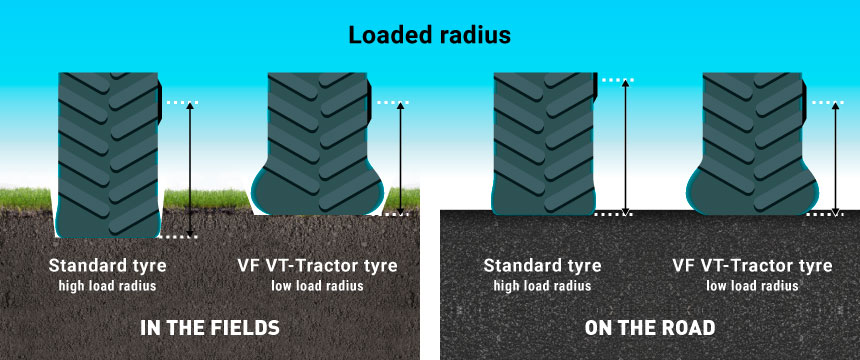 VF technology VT Tractor tyres
VF technology VT Tractor tyres
have a smaller load radius than standard tyres
2. Reducing the load radius is an advantage
A low load radius is good for traction
The load radius is reduced when you increase the load or you decrease the inflation pressure, if you work with VF tyres for example. The more you lower the load radius, the larger the size of your soil footprint will become. This is a real advantage in improving traction with your trailed implements.
The larger the contact patch with the ground, the more lugs there are to take hold on the ground, which improves traction mechanically. Your slip ratio will be reduced and your engine power is transmitted to the ground better, which allows you to save time in completing your operations.
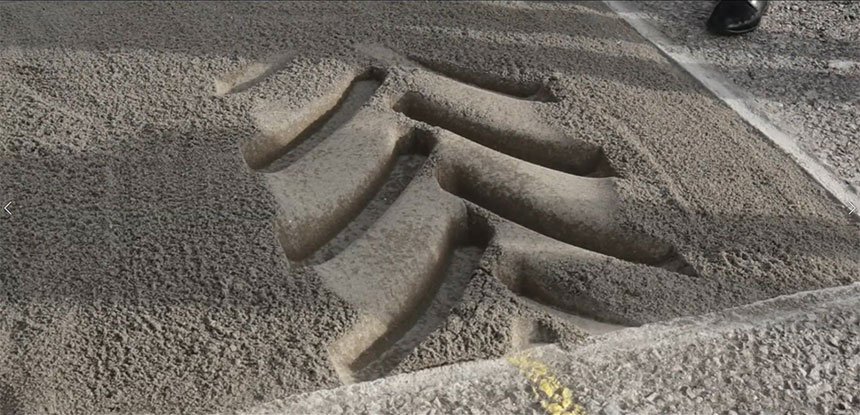 Soil footprint test with low-pressure VT-Tractor tyres
Soil footprint test with low-pressure VT-Tractor tyres
Reducing the load radius is good for soil preservation
A reduced load radius means a larger and longer soil footprint, so that the load is spread over a larger surface area. The more the tyre flattens out, the less it sinks into the loose soil. This distribution of the load therefore has a direct influence on your tyres’ capacity to preserve the soil and reduce deep soil compaction.
3. A reduced load radius means less rolling resistance
Rolling resistance acts against the power that your tractor must develop to allow the tyres to move forward on any given ground.
This resistance is directly proportional to the weight bearing down on all the wheels of your tractor.
When the tractor is stationary, its mass pushes down vertically and is balanced out by the ground’s bearing capacity. As the tyre and the ground are both deformable elements, the tyre flattens out while the soil compacts, until the opposing forces balance out. The tyre’s rolling resistance is the result of these two crushing forces.
If the loaded radius is reduced, the tyre sinks less into the ground and the load is absorbed by a larger soil footprint.
For your tractor, rolling resistance uses up between 20 and 35% of your engine power. The greater the quantity of earth in front of your tyre, the more extra engine power will be needed to move forward.
Adapting the loaded radius is achieved through perfect knowledge of the weight borne by the tyres as well as the technical data relating to tyre size characteristics.
The Bridgestone-agriculture.eu blog is written and administered by tractor tyre experts who are available to provide you with the advice you need on the subject of your agricultural tyres. They allow you to maximise your productivity with information on all subjects linked to tyres: Cheap tractor tyres — Technical data for agricultural tyres — Air pressure advice — Solutions to avoid soil compaction — Sprayer tyre pressure — Why and how to ballast your tractor tyres — When to use dual wheels — The mechanical causes of abnormal wear — Cheap agricultural tyres – etc.
To learn more and boost your farm's profits, Bridgestone-Agriculture is offering you a free, detailed white paper that explains the essential role your agricultural tyres play in your productivity.
Most people who read this article have also read some of the following articles:
- 5 essential techniques to optimise your agricultural tyres
- Agricultural contracting companies: improve team awareness about tyres
- Equipment sharing cooperatives: How to manage the agricultural tyre budget?
- Duals or low-pressure agricultural tyres: which to choose?
- What is the maximum load that your tractor tyres can carry?
- How do you ensure that your tractor tyres have a good self-cleaning capacity?
- Agricultural tyre evolution, what impact on my farm?
- Agricultural contractors: improving quality of service with an adapted agricultural tyre
- Which vibrations are directly linked to agricultural tyres?
- Load comparison between standard agricultural tyres and VF tyres
This information is intended only to make you aware of the technical and functional aspects of agricultural tires and their use. It does not allow you to make a judgment or a definitive conclusion on a given problem. Only your agricultural tire expert is able to make a technical assessment and take a final decision, case by case.
Leave a
commentary
Your email address will not be published.
Required fields are indicated with *


